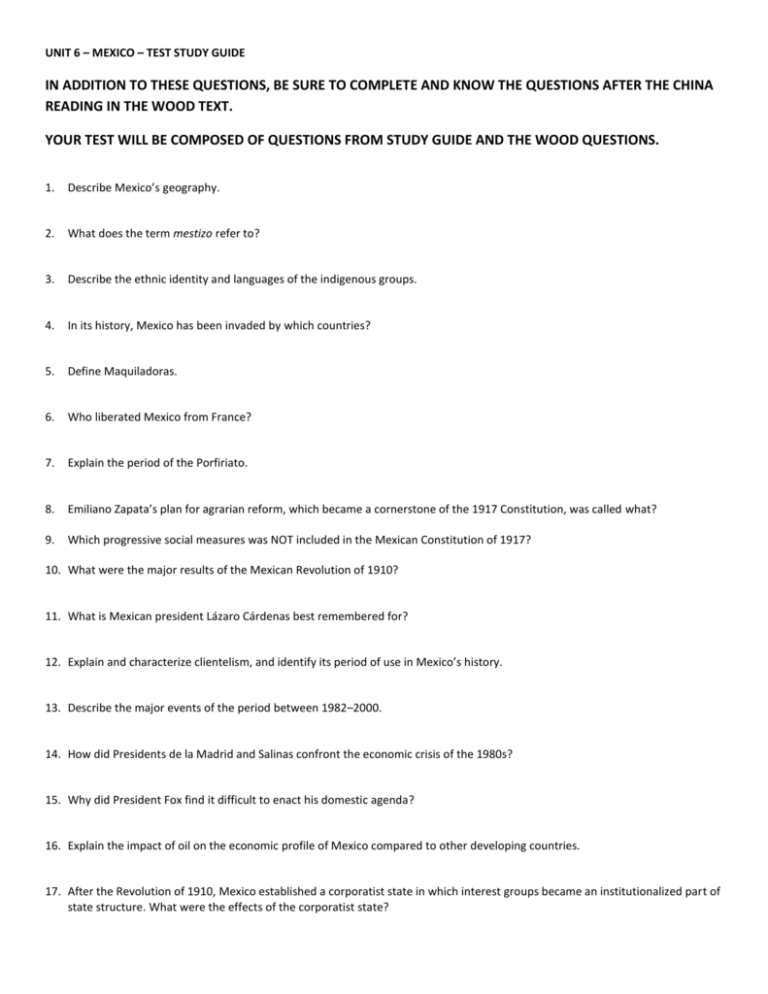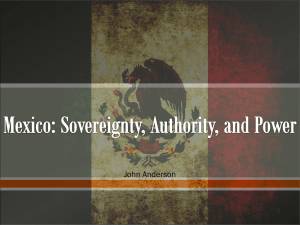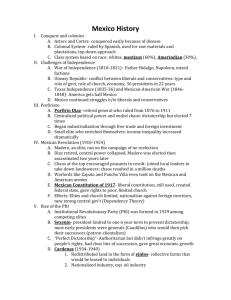UNIT 6 – MEXICO – TEST STUDY GUIDE IN ADDITION TO THESE
advertisement

UNIT 6 – MEXICO – TEST STUDY GUIDE IN ADDITION TO THESE QUESTIONS, BE SURE TO COMPLETE AND KNOW THE QUESTIONS AFTER THE CHINA READING IN THE WOOD TEXT. YOUR TEST WILL BE COMPOSED OF QUESTIONS FROM STUDY GUIDE AND THE WOOD QUESTIONS. 1. Describe Mexico’s geography. 2. What does the term mestizo refer to? 3. Describe the ethnic identity and languages of the indigenous groups. 4. In its history, Mexico has been invaded by which countries? 5. Define Maquiladoras. 6. Who liberated Mexico from France? 7. Explain the period of the Porfiriato. 8. Emiliano Zapata’s plan for agrarian reform, which became a cornerstone of the 1917 Constitution, was called what? 9. Which progressive social measures was NOT included in the Mexican Constitution of 1917? 10. What were the major results of the Mexican Revolution of 1910? 11. What is Mexican president Lázaro Cárdenas best remembered for? 12. Explain and characterize clientelism, and identify its period of use in Mexico’s history. 13. Describe the major events of the period between 1982–2000. 14. How did Presidents de la Madrid and Salinas confront the economic crisis of the 1980s? 15. Why did President Fox find it difficult to enact his domestic agenda? 16. Explain the impact of oil on the economic profile of Mexico compared to other developing countries. 17. After the Revolution of 1910, Mexico established a corporatist state in which interest groups became an institutionalized part of state structure. What were the effects of the corporatist state? 18. Explain the economic policies Mexico pursued throughout much of the twentieth century. 19. What does the Mexican Miracle of the 1950s and 1960s refer to? 20. What were the effects of Import substitution industrialization? 21. Which groups were hurt by import substitution industrialization? 22. Explain the results of the discovery of large oil reserves in the 1970s. 23. Why were the 1985 earthquakes in Mexico City a watershed in Mexican politics? 24. Between 1988 and 1994, PRI presidents introduced a series of reforms to liberalize the economy and thus end the country’s traditional import substitution industrialization policy. What were some of the major economic reforms? 25. Describe how Mexico has addressed environmental problems during rapid industrialization and urbanization. 26. Why are the northern areas of the country more economically advanced than the southern regions? 27. Describe the historical relationship of many Mexican immigrants to the United States. 28. What has been the affect of NAFTA as it relates to Mexico? 29. Describe the formation and amendment process of the Mexican Constitution 30. How are members of the Chamber of Deputies elected? 31. What is the term length a president is elected for? 32. The members of the Chamber of Deputies are elected every _____ years whereas the members of the Senate are elected every ______ years. 33. How was the PRI’s presidential candidate selected, during the period of party’s dominance? 34. Describe all of the formal powers of the Mexican president. 35. During the period of PRI dominance, Mexican presidents generally had what kind of background? 36. Describe the relationship between the President and the cabinet members. 37. Describe the history and current president’s authority and power of leadership appointments. 38. Explain the role, structure, and organization of the bureaucracy. 39. Define parastatals. 40. Explain the development, structure, and growth of the parastatal sector. 41. Explain the multiple roles of the military in Mexico. 42. Explain the role of the courts importance on the national and state levels. 43. Explain how state and municipal governments in Mexico are organized. 44. What is an indication of the changing role of state and local governments? 45. In terms of its impact on the policy-making process, describe the role of sexenio. 46. Historically, how have Mexican citizens interacted with their government? 47. What has become common since the 1990’s of the political parties who hold the presidency and the congress? 48. What measures were adopted to make it easier for political parties to participate politically? 49. How was the PRI founded and their beliefs that shaped it? 50. The PRI historically was organized in a corporatist fashion in which the interests of certain social groups were represented through national organizations. Which groups were represented in the party’s structure? 51. Describe the PRI’s structure of leadership and the relationship of its leaders and support groups. 52. From what region has the PAN drawn most of its political support from? 53. The PAN has traditionally run on a platform that includes what values? 54. What has always been a key consistent difference between the PRI and the PAN? 55. What is a significant factor that inhibits the prospects of the PRD? 56. Describe how other political parties are organized, the results of their campaigning efforts, and the effects of influence on national policy. 57. Which party is most vulnerable to the demographic changes in the country? 58. What current problem might be a potential limit on the future role of the media in Mexican politics? 59. Which of the following is NOT true? A. The Mexican government has traditionally responded to organized interests through pragmatic accommodation. B. Where open conflict has occurred between organized interests and the government, the government has been quick to rely upon repression rather than to seek some kind of compromise solution. C. There is a long tradition in Mexico of civic organizations operating at the local level with considerable independence from politics. D. Urban popular movements, organized around issues that cut across class boundaries, have been increasingly visible in Mexico since the 1980s. E. The earthquake of 1985 encouraged the formation of unprecedented numbers of grassroots movements in response to the slow and poorly managed relief efforts of the government. ANS: B REF: 469 | 470 NOT: Applied 60. What are the major assets that are beneficial to Mexico during its democratic transition? ESSAY 1. How did the PRI maintain control over Mexico for so long without facing significant challenges to its power? Please cite specific examples in your answer. 2. What factors helped to bring about the end of the PRI’s hegemonic position? Why was the party unable to adequately respond to these factors? 3. What economic developments in Mexico have had the greatest effects, both good and bad, on the country and its citizenry? To what extent has government policy affected such developments? To what degree where they shaped by outside forces? Please use specific examples in your answer. 4. In what ways does the actual distribution of power differ from the model outlined in the Constitution? What are the main reasons for such discrepancies? How has the ongoing democratization progress affected such discrepancies? 5. Since the 1980s, how has the balance of power between the executive and legislature shifted? What accounts for these shifts? What impact has these shifts have upon the policy making process in the country? 6. In most countries previously controlled by a single party, the democratic transition has seen the previously controlling party wither away. This has not occurred in Mexico. Why has this been the case? Given this, what challenges must the PRI overcome to continue to remain politically important in Mexico?






